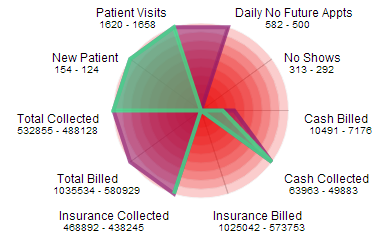Genesis Chiropractic Software Webinar Teaches Three Key Practice Compliance Skills

Industry leaders unveil tested strategies in chiropractic practice management software to increase office compliance and save practice owners time and money in this short new webinar. Genesis Chiropractic’s new short webinar reveals three most effective methods to increase compliance in the office, thus saving chiropractors time and money. The webinar is available online, and can be watched or listened to on a computer here at any time. “Ninety healthcare providers were charged with compliance violations reaching $260 million in billing in May 2014. A growing number of practices are subjected to audits and penalties,” says Reuven Lirov, Chief Practice Growth Officer at Vericle. “Chiropractic practice owners too struggle to maintain compliant practices against a tangled web of regulations from insurance companies, the government, Medicare, and Medicaid.” Each of those unbilled visits would be marked as a “fail” in the audit, with a resulting penalty of $10,000 per line item. According to Lirov, mistakes and oversights in the office are a regular occurrence in most healthcare practices. “Chiropractic office practice managers face difficult problems posed by compliance issues such as the increased risk of audit failure, growing compliance complexity, and lack of time to learn and implement new procedures based upon new rules,” says Lirov. Lack of compliance is a serious issue that can lead to substantial loss of revenue and fines. For example, a chiropractic office might see 100 patients a day, or approximately 25,000 patients a year. Suppose just 0.4% of those visits (100 visits) are undocumented. Each of those unbilled visits would be marked as a “fail” in the audit, with a resulting penalty of $10,000 per line item — or $1 million in audit penalties. “Better compliance liberates chiropractic practice owners from worrying about fines and audits, and lets them get back to treating patients,” says Lirov. “Chiropractic practice management software helps practice owners stay compliant and grow. Our average clients have seen substantial growth in their practices including an average revenue growth of 186% and patient growth of 141%.” [vc_video title=”Dr. Greg Loman D.C. talks about compliance.” link=”https://youtu.be/i0slFN2U1GA”] “We’re in a compliance era in which we must really become compliant,” says Dr. Greg Loman D.C., an accomplished physician, a high volume practice owner, and a co-founder of Maximized Living. “In my opinion it is just necessary that you use Genesis Chiropractic Software by Billing Precision not just a for compliance but for just how amazing their product is.” Continuously increasing compliance requirements and lack of time do not excuse chiropractic practice owner during a practice audit. This short thirty minute webinar teaches the three most important practice management skills to save a chiropractic office and avoid audit failure penalties. The webinar includes a demonstration of Genesis chiropractic practice management software. It contains automated features to discover the most frequent documentation errors that lead to compliance issues, such as undocumented visits, unsigned notes, and late billing. The software is also browser-based, so it can be changed as the law changes without inconveniencing the practice owner. Click here to sign up for the free webinar and find out more information. About Genesis Chiropractic Software and Billing Precision, LLC Genesis Chiropractic Software by Billing Precision, LLC was designed by chiropractic business owners with both patient relationship management and practice profitability in mind. Genesis software provides a complete chiropractic practice management system that supports every role in a busy chiropractic practice, from the owner and practitioners to the front desk and back office. It automates the vast majority of standard tasks, including patient relationship management, revenue cycle management, compliance and office management. Its exclusive workflow functionality continuously improves productivity, control and predictability, fostering teamwork and time savings, which leads to greater profitability and practice growth. Visit https://genesischiropracticsoftware.com for more information.
Revenue | Automating Billing Reports

Where Should We Go Tonight? Can Dr. Ben make the commitment to automate his billing reports and take control of his office finances? Ben and Carmen were having a familiar conversation: what should we do about dinner? They had both returned home from busy days at work, both were a little frazzled and hungry and – as usual – the refrigerator was lacking in appetizing options. “I’ve heard that the new Indian buffet is very good,” said Carmen. “But it’s downtown and it’s almost 6:30, so there might be a bit of a wait.” Ben thought about that. “That sounds delicious and we should definitely get there at some point, but I’m too hungry for a long wait. Why don’t we just go grab some Chinese at our usual place – there’s never a wait there.” “You know, Ben, we’re never thrilled with our meals there and we’ve tried everything on the menu,” Carmen said. “There’s a pretty good reason why there’s never a wait there.” They looked at each other testily for a moment – hunger and a lack of accord might become a threat to their nice evening out. Just then Jonathan came running out of the living room and hugged Ben, happy to see his father. “Daddy, you’ve got to see my new art book – I drew all of the pictures myself!” “Of course, Jonathan, I’d love to see it,” Ben said. “Listen, Carmen, I’m going to look at Jonathan’s artwork and then we can go try that new restaurant downtown. It sounds like fun.” He went into the living room with Jonathan and sat down on the couch with him. He wondered why he was so irritable this evening as he turned the pages of the book. Ben’s thoughts kept returning to earlier in the week, when Luisa explained the difficulty she was having keeping track of the office finances. Too often they were surprised to learn that some patients had accounts that were past due. And between varying accounts receivable windows and some insurance companies that were dragging out the reimbursement process due to even minor errors in data entry, it was making confident budgeting impossible. Ben pondered how difficult it was for him to keep track of crucial patient information until he put a system in place. Between his voice recorder, written notes and meticulously organized files on his computer, he felt confident in his mastery of the most important details for each patient. But then he thought about how many areas of office management that Luisa was expected to stay abreast of: office supplies, scheduling, working with outside vendors, insurance reimbursements… her plate was truly full, even with Pam’s able assistance. And considering that third parties don’t always respond when and how you want them to, the level of complexity and the time it takes to handle each task can be multiplied exponentially. Carmen – who had a business degree and always seemed to be several steps ahead of Ben in understanding the ins and outs of finance – and he had talked about the program that could automate many of the functions of his office and Ben had been serious about actually following through and implementing it. But there always seemed to be a crisis to attend to… trying to collect from patients who owe balances beyond a certain date, trying to figure out where long-overdue insurance reimbursements were. Ben knew when he started his practice that it wouldn’t only be about attending to patients – he knew there would be crucial administrative work that would have to be handled by his staff. Luisa had certainly had shown she understood the benefits of having data to inform business decisions. But customization is key when reviewing large amounts of detailed data and it didn’t seem like Luisa was tapping the full potential of the system when it came to the billing reports. Ben knew that there were reports that could be broken down in a number of different ways and could be endlessly customized so that they could stay on top of potential problems. Well, maybe we should take some time to figure it out together, Ben thought. Without getting these reports done – and done right – we really have no idea how well our office is functioning. This sounds like something we should talk about on Monday. But first he wanted to enjoy a nice dinner with Carmen and Jonathan. He appreciated how Carmen listening to him talk about the various issues in his office, and she often responded with some great feedback. That business degree had served both of them well over the years. When Ben had finished looking at Jonathan’s artwork and congratulating him on being the next Rembrandt, he found Carmen in the hallway, ready to go – her purse in one hand and a small lunchbox in the other. “What’s in the lunchbox, Carmen?” Ben asked. “Well, since you’ve agreed to my pick of restaurants, I wanted to reciprocate by packing some snacks for the drive so you won’t be starving while we wait for a table,” Carmen said with a smile. “I’ve got some fruit, cheese and crackers, and your favorite – cashews.” Ben took Jonathan’s hand and smiled at Carmen, who never failed to make even the most hectic and frustrating day better. “We’d better get going,” he said. “Maybe we can be on the lookout for a new Chinese place on our way there.” Both were laughing on their way out the door. Can Dr. Ben make the commitment to automate his billing reports and take control of his office finances? Disclaimer: For HIPAA compliance, all characters appearing in this post are fictitious. Any resemblance to actual persons or actual events is purely coincidental.
Chiropractic Software Patient Education Increases Compliance

Personal Growth Could patient education help reduce Dr. Ben’s exasperation with compliance? Ben pulled a weed viciously. His wife looked at him with raised eyebrows. “What did that dandelion ever do to you?” “I guess I’m just exasperated,” Ben said, tossing the weed into a wheelbarrow and starting in on another. “You can take out all your exasperation on these weeds,” Carmen laughed. “But tell me what you’re upset about.” “Another no-show this afternoon!” Ben said, pulling more weeds with more force than was absolutely necessary. “I’m just getting sick of it.” “I thought you had worked out –” “Oh, we have a good system in place now, as far as the practice is concerned. But I still hate it. This particular patient skips half her regular adjustments, and then comes in with pain and emergencies that she probably wouldn’t have if she just followed her treatment plan. It’s frustrating to know that I can’t do my best for her because she won’t cooperate and be in compliance.” Carmen nodded sympathetically, digging out a stubborn root. “I sometimes think,” Ben went on, sitting back on his heels, “that they don’t really get what we’re doing.” “Maybe they don’t,” Carmen suggested. She reached across to help their son with a tough weed he was trying to pull. “They act like what you do is magic. They don’t know why it works, they just feel happy that it does.” “But you see, that attitude means that they don’t follow through with my recommendations.” “You explain things clearly, I know,” Carmen assured him. “I’ve heard you do it.” “Better sometimes than at other times,” Ben admitted. “It depends how busy I am, and which room I’m in — some have better visual aids than others.” Carmen laughed again. “I hadn’t thought of that, but it’s true. Plus, you’re not always the one giving the explanation. It’s not really systematic, is it?” “I guess it’s not,” Ben agreed. “We all just answer questions and give explanations as needed — office staff, too. And of course we work together on patient cases, or with other health care professionals. There can be a lot of people involved in a single medical decision, and we don’t all end up sharing the same information.” “I don’t do a lot of education in my business,” Carmen said, “but I know that anything that doesn’t use a good system ends up taking more work, more time, and more trouble than it needs to.” “Hmm.” Ben stood up, brushing dirt from his knees, and hoisted the wheelbarrow. “It sounds like non-compliant patients are my fault.” “That’s not how I meant it,” objected Carmen. Jonathan scrambled up into the wheelbarrow, shouting that he wanted a ride. “I’m just going with what you said — they don’t always get what you’re doing. Then they might not realize the importance of doing their part.” “I’m doing my part,” Jonathan announced. His parents assured him that he was, and Carmen lifted him down from the wheelbarrow so Ben could tip the weeds onto the compost pile. “A little patient education might do wonders,” Ben said. “I hadn’t really thought about it, but I’m sure the patients would be more cooperative if they understood the value of follow through.” Could patient education help reduce Dr. Ben’s exasperation? Disclaimer: For HIPAA compliance, all characters appearing in this post are fictitious. Any resemblance to actual persons or actual events is purely coincidental.
Visual Embedded Analytics in Your Software

Can of Worms What do the numbers mean to you and your practice? Opening your own practice means opening a whole new can of worms. That’s because there are so many elements that they don’t teach you about in school: aspects of running a business that you’re left to learn on the fly — all while attempting to provide quality care for your patients. One of the most critical components of achieving practice success is making sense of the numbers. There are numbers everywhere, from revenue to no-shows, from patient visits to accounts receivable. When you first start to look at them, it can almost seem like you’re staring at signs in a foreign language, hoping that the context might shed some light on what they mean. Practice management software can help, but until you know what numbers are most important to your practice — and how they signify growth or, conversely, difficulties — you’re still left wading through a mess of mathematical gobbledygook. Fortunately, there are analytics — tools to help you make sense of the data — available, and the best chiropractic software solutions, such as Genesis, embed those tools into the program so that they’re easily and immediately accessible. Offering a visual presentation of the numbers, these analytics finally make it possible for you to interpret and understand the numbers that drive your practice. Examples include: Radar chart — Visually resembling a spiderweb, the radar chart shows multiple variables on axes starting from the same point, radiating outward like spokes on a wheel. The length of the spoke is proportional to the magnitude of the data. This allows you to examine the correlation of values — say, accounts receivable and NFAs — that aren’t otherwise measured in comparable units. Trend report — A trend report presents data on a traditional line graph, thereby allowing you to see the peaks and valleys of your information — and the inter-relation of different data sets — over time. Histogram — With a histogram, you can choose three charts to show you a graphical representation of a single area of your practice over a given time period (weekly/monthly), depending on the selection. This allows you to gauge how your practice is doing comparatively for a set amount of time. Dashboard — A dashboard is an organized presentation of the numbers, so you can get an at-a-glance picture of where your practice stands on collections and outstanding work. Genesis, for example, can show you failed claims, AR > 120 and outstanding tasks — or “tickets” — on a single screen through its homescreen dashboard. Billing Stats Report — This type of report allows you to view claims by date of service. The report can then be broken down in a number of different ways, depending on what you’re looking for (customizable by practice). The Billing Stats Report, or BSR, is very useful for digging into problems. Ultimately, it’s up to you to determine which numbers provide the best snapshot of practice success; however, analytics are the tools that help bring that snapshot into focus.

